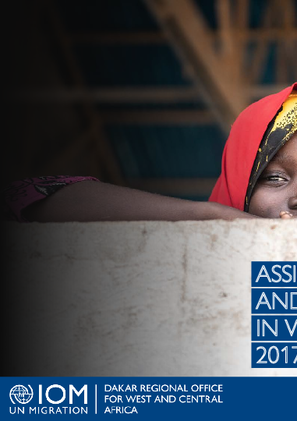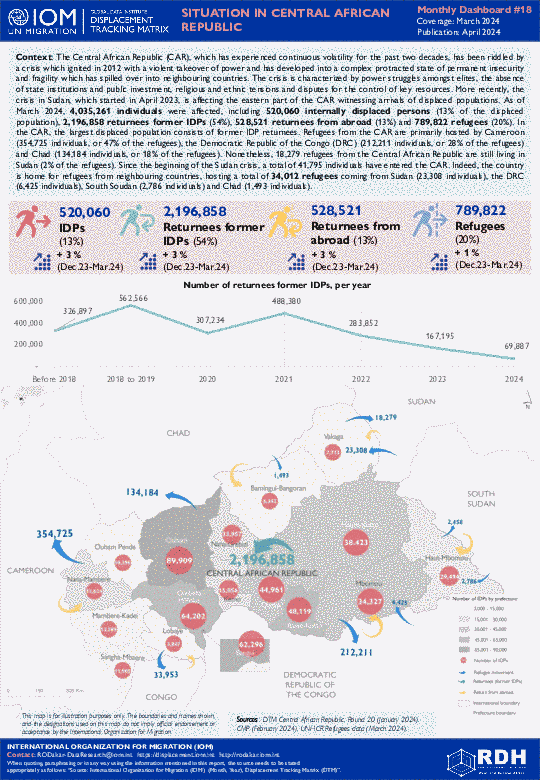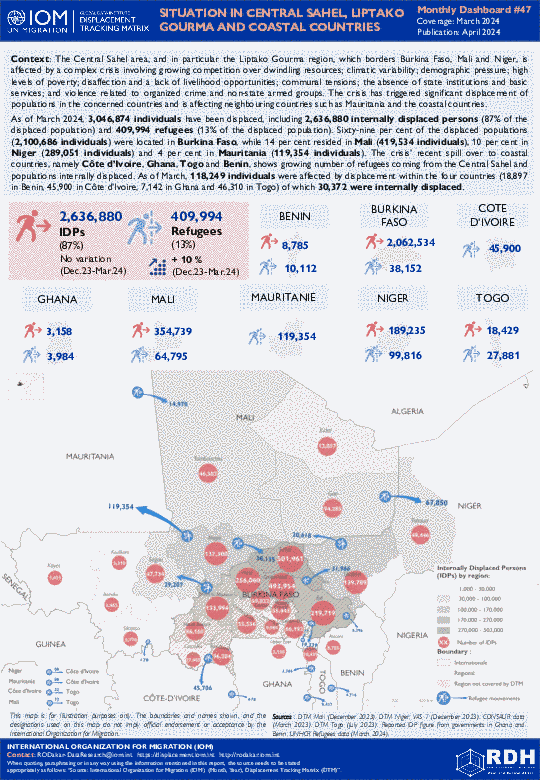-
Countries
-
Data and Analysis
-
Special Focus
-
Crisis Responses
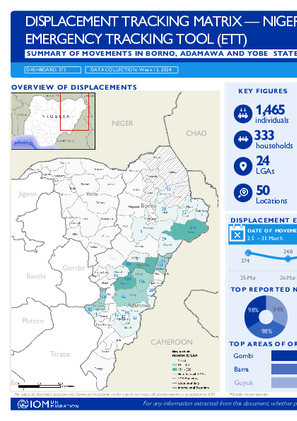
Contact
DTM Nigeria, iomnigeriadtm@iom.int
Language
English
Location
Nigeria
Period Covered
Mar 25 2024
Mar 31 2024
Activity
- Mobility Tracking
- Event Tracking
Between 25 and 31 March 2024, a total of 1,465 new arrivals were recorded at locations in Adamawa and Borno states. The new arrivals were recorded at locations in Askira/Uba, Bama, Chibok, Dikwa, Gwoza, Hawul, Kala Balge, Konduga, Mafa, Monguno and Ngala Local Government Areas (LGAs) of the most conflict-affected Borno State, and in Fufore, Girei, Gombi, Guyuk, Hong, Lamurde, Madagali, Maiha, Michika, Numan, Song, Yola North and Yola South LGAs of Adamawa State.
ETT assessments identified the following movement triggers: family re-unification (291 individuals or 20%), seasonal farming (227 individuals or 15%), poor living conditions (214 individuals or 15%), improved security (213 individuals or 14%), military operations (199 individuals or 14%), attack (186 individuals or 13%), fear of attack (78 individuals or 5%) and access to humanitarian support (57 individuals or 4%).
Contact
dtmlebanon@iom.int
Location
Lebanon
Activity
- Mobility Tracking
- Baseline Assessment
Period Covered
Oct 10 2023 -Apr 02 2024
Since October 8 there has been an increase in cross-border incidents between Israel and Lebanon, resulting in the displacement of people both within the South and elsewhere within the country. Since October 10, the Displacement Tracking Matrix (DTM) has been conducting the daily monitoring of population movements. The objective of the exercise is to inform preparedness and response planning.
Aggregated data is available through the DTM API: https://dtm.iom.int/data-and-analysis/dtm-api
A more detailed version of this dataset is available, to get access kindly click on the 'Request Access' button
Population Groups
IDPs
Survey Methodology
Unit of Analysis Or Observation
Admin Area 2
Admin Area 3
Household
Individual
Type of Survey or Assessment
Key Informant
Keywords
Geographical Scope Full Coverage
Administrative boundaries with available data
The current dataset covers the following administrative boundaries

Contact
DTM Europe, DTMMediterranean@iom.int
Language
English
Location
Estonia
Period Covered
Mar 01 2023
Dec 31 2023
Activity
- Survey
- Flow Monitoring
This report is based on a survey of displacement patterns, needs and intentions conducted by IOM’s Displacement Tracking Matrix (DTM) in the 11 countries included in the Regional Response Plan for Ukraine in 2023: 6 countries neighboring Ukraine – Belarus, Hungary, Poland, Republic of Moldova, Romania and Slovakia – and other 5 countries particularly impacted by the arrivals of refugees from Ukraine since the start of the war in February 2022 – Bulgaria, Czechia, Estonia, Latvia and Lithuania.
The analysis provided in this report is based on annual data collected from March to December 2023.

Contact
dtmlebanon@iom.int
Language
English
Location
Lebanon
Period Covered
Oct 10 2023
Apr 09 2024
Activity
- Mobility Tracking
- Baseline Assessment
Since October 8 there has been an increase in cross-border incidents between Israel and Lebanon, resulting in the displacement of people both within the South and elsewhere within the country. Since October 10, the Displacement Tracking Matrix (DTM) has been conducting the daily monitoring of population movements. The objective of the exercise is to inform preparedness and response planning.
This document presents an analysis of interviews conducted with all individuals assisted in their voluntary return by the International Organization for Migration (IOM) between 2017 and 2023 to one of the 23 countries covered by the West and Central Africa region (WCA). The analysis combines datasets from both Assisted Voluntary Return and Reintegration (AVRR) and Voluntary Humanitarian returns (VHR).

Contact
DTMThailand@iom.int
Language
English
Location
Thailand
Period Covered
Dec 29 2023
Mar 15 2024
Activity
- Survey
- Site Assessment
This factsheet aims to provide a snapshot of multi-sectoral conditions, needs, and challenges among Myanmar migrants in Kanchanaburi province as captured between December 2023 and March 2024 by IOM Thailand’s multi-sectoral assessment of needs. The purpose of this assessment is to provide insights regarding the severity of needs among migrant populations, identify vulnerable population groups and geographic areas with the most acute needs, inform assistance planning and relevant Sustainable Development Goals (SDGs) targets, and provide sectoral and inter-sectoral baselines for future assessments.
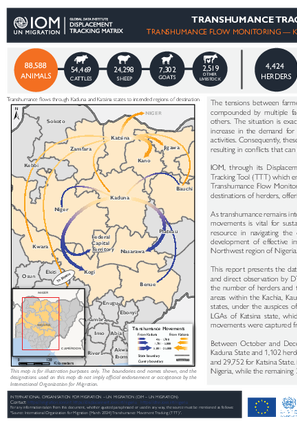
Contact
DTM Nigeria, iomnigeriadtm@iom.int
Language
English
Location
Nigeria
Period Covered
Oct 01 2023
Dec 31 2023
Activity
- Survey
- Flow Monitoring
This report presents the data collected between October and December 2023, through direct interviews and direct observation by DTM enumerators and triangulated via a network of key informants. It highlights the number of herders and their herds identified at 45 counting points. Between October and December 2023, the Transhumance Flow Monitoring tool identified 3,322 herders in Kaduna State and 1,102 herders in Katsina State. The animal count was estimated at 58,836 for Kaduna State and 29,752 for Katsina State. Notably, 80 per cent of the total number of herders departed from states within Nigeria, while the remaining 20 per cent departed from Niger.
The Central African Republic (CAR), which has experienced continuous volatility for the past two decades, has been riddled by a crisis which ignited in 2012 with a violent takeover of power and has developed into a complex protracted state of permanent insecurity and fragility which has spilled over into neighbouring countries. The crisis is characterized by power struggles amongst elites, the absence of state institutions and public investment, religious and ethnic tensions and disputes for the control of key resources. More recently, the crisis in Sudan, which started in April 2023, is affecting the eastern part of the CAR witnessing arrivals of displaced populations.
As of March 2024, 4,035,261 individuals were affected, including 520,060 internally displaced persons (13% of the displaced population), 2,196,858 returnees former IDPs (54%), 528,521 returnees from abroad (13%) and 789,822 refugees (20%). In the CAR, the largest displaced population consists of former IDP returnees. Refugees from the CAR are primarily hosted by Cameroon (354,725 individuals, or 47% of the refugees), the Democratic Republic of the Congo (DRC) (212,211 individuals, or 28% of the refugees) and Chad (134,184 individuals, or 18% of the refugees). Nonetheless, 18,279 refugees from the Central African Republic are still living in Sudan (2% of the refugees). Since the beginning of the Sudan crisis, a total of 41,795 individuals have entered the CAR. Indeed, the country is home for refugees from neighbouring countries, hosting a total of 34,012 refugees coming from Sudan (23,308 individuals), the DRC (6,425 individuals), South Soudan (2,786 individuals) and Chad (1,493 individuals).
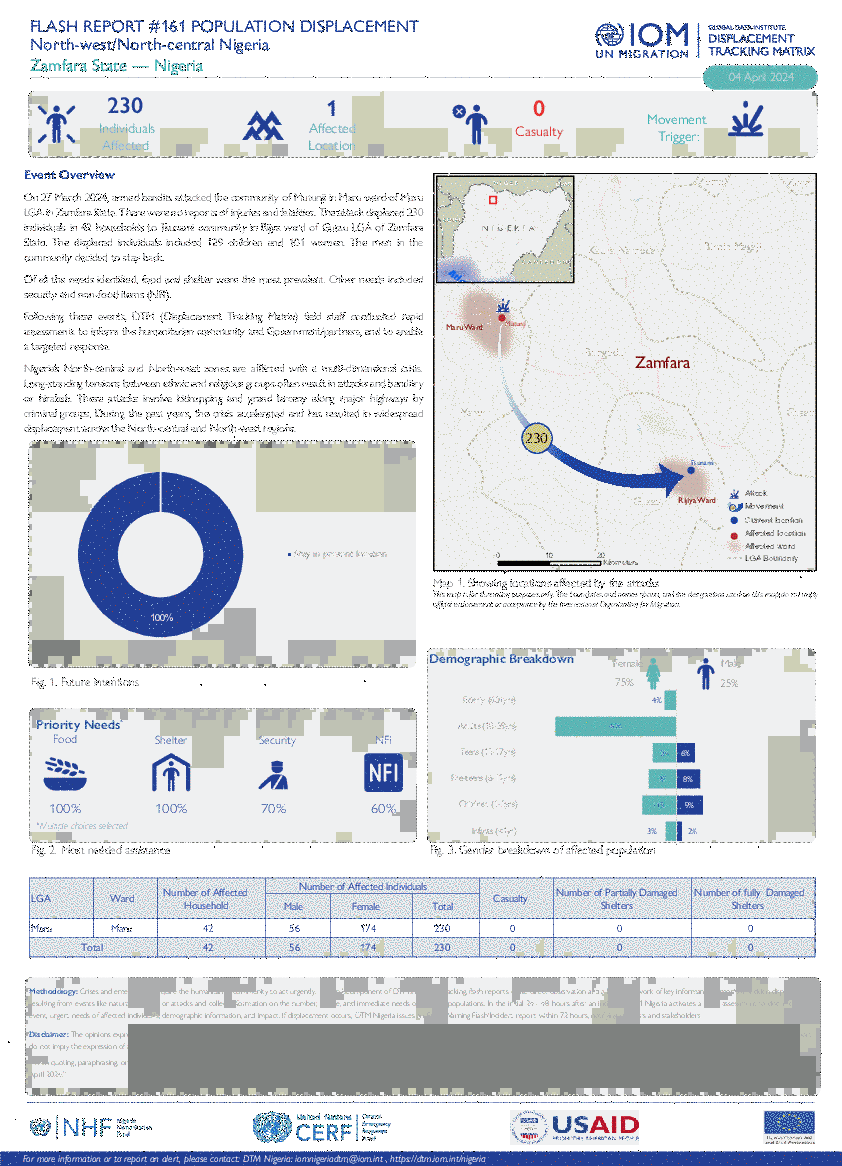
Contact
DTM Nigeria, iomnigeriadtm@iom.int
Language
English
Location
Nigeria
Period Covered
Mar 25 2024
Mar 31 2024
Activity
- Mobility Tracking
- Event Tracking
On 27 March 2024, armed bandits attacked the community of Mutunji in Maru ward of Maru LGA in Zamfara State. There were no reports of injuries and fatalities. The attack displaced 230 individuals in 42 households to Tsunami community in Rijya ward of Gusau LGA of Zamfara State. The displaced individuals included 129 children and 101 women. The men in the community decided to stay back.
Of all the needs identified, food and shelter were the most prevalent. Other needs included security and non-food items (NFI).
Following these events, DTM (Displacement Tracking Matrix) field staff conducted rapid assessments to inform the humanitarian community and Government/partners, and to enable a targeted response.
Nigeria’s North-central and North-west zones are afflicted with a multi-dimensional crisis. Long-standing tensions between ethnic and religious groups often result in attacks and banditry or hirabah. These attacks involve kidnapping and grand larceny along major highways by criminal groups. During the past years, the crisis accelerated and has resulted in widespread displacement across the North-central and North-west regions.
The Central Sahel area, and in particular the Liptako Gourma region, which borders Burkina Faso, Mali and Niger, is affected by a complex crisis involving growing competition over dwindling resources; climatic variability; demographic pressure; high levels of poverty; disaffection and a lack of livelihood opportunities; communal tensions; the absence of state institutions and basic services; and violence related to organized crime and non-state armed groups. The crisis has triggered significant displacement of populations in the concerned countries and is affecting neighbouring countries such as Mauritania and the coastal countries.
As of March 2024, 3,046,874 individuals have been displaced, including 2,636,880 internally displaced persons (87% of the displaced population) and 409,994 refugees (13% of the displaced population). Sixty-nine per cent of the displaced populations (2,100,686 individuals) were located in Burkina Faso, while 14 per cent resided in Mali (419,534 individuals), 10 per cent in Niger (289,051 individuals) and 4 per cent in Mauritania (119,354 individuals). The crisis’ recent spill over to coastal countries, namely Côte d’Ivoire, Ghana, Togo and Benin, shows growing number of refugees coming from the Central Sahel and populations internally displaced. As of March, 118,249 individuals were affected by displacement within the four countries (18,897 in Benin, 45,900 in Côte d’Ivoire, 7,142 in Ghana and 46,310 in Togo) of which 30,372 were internally displaced.
